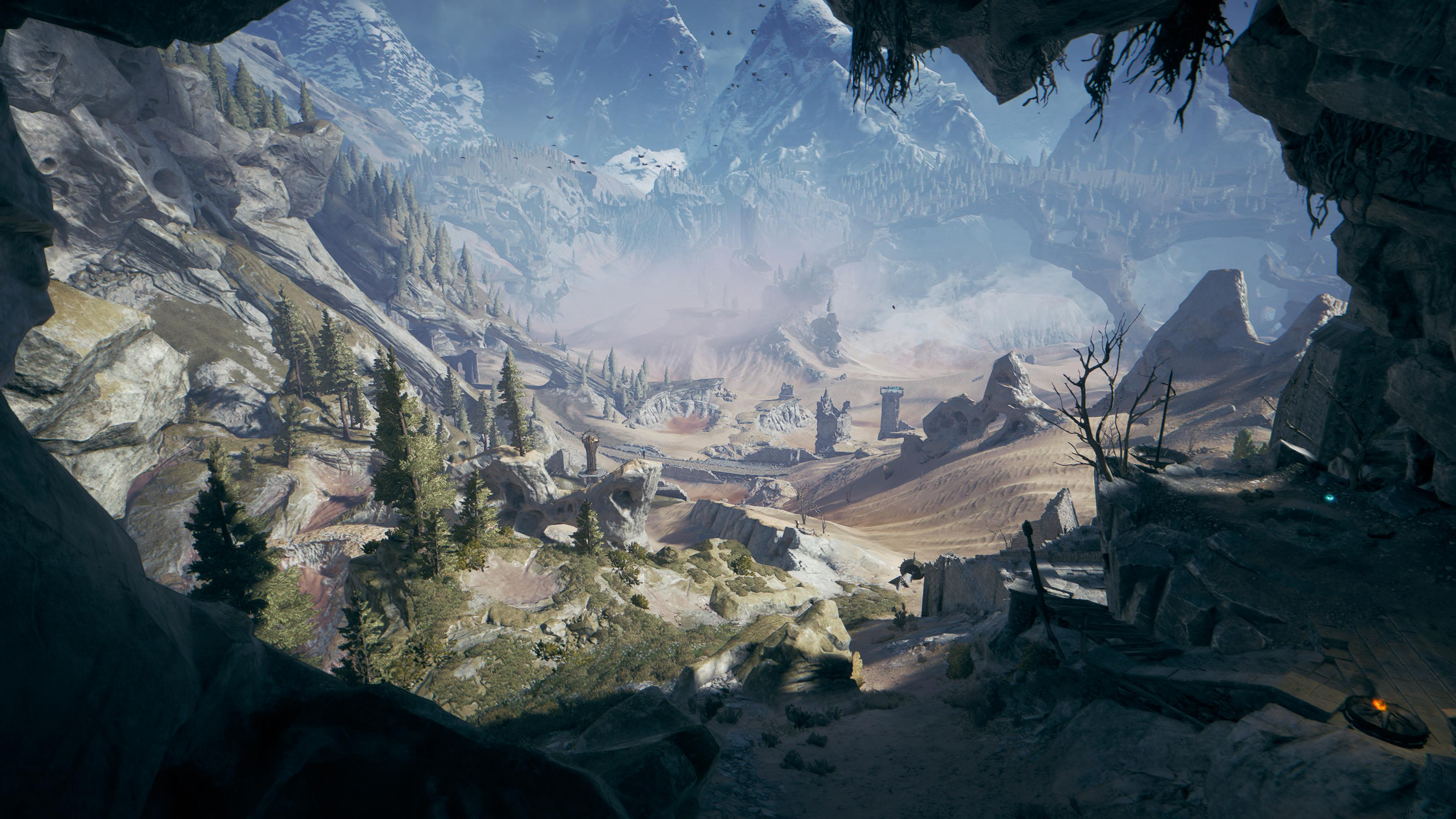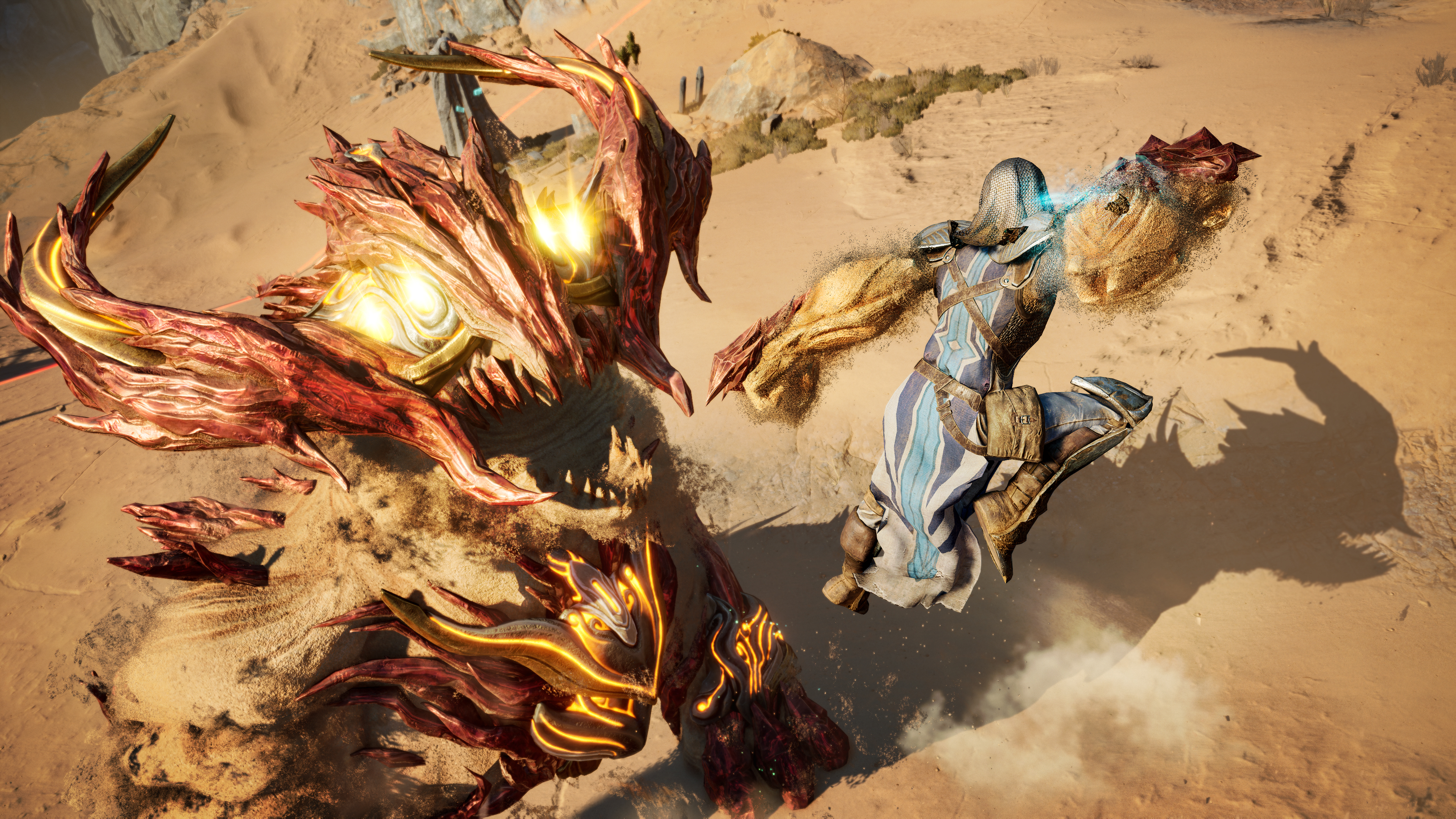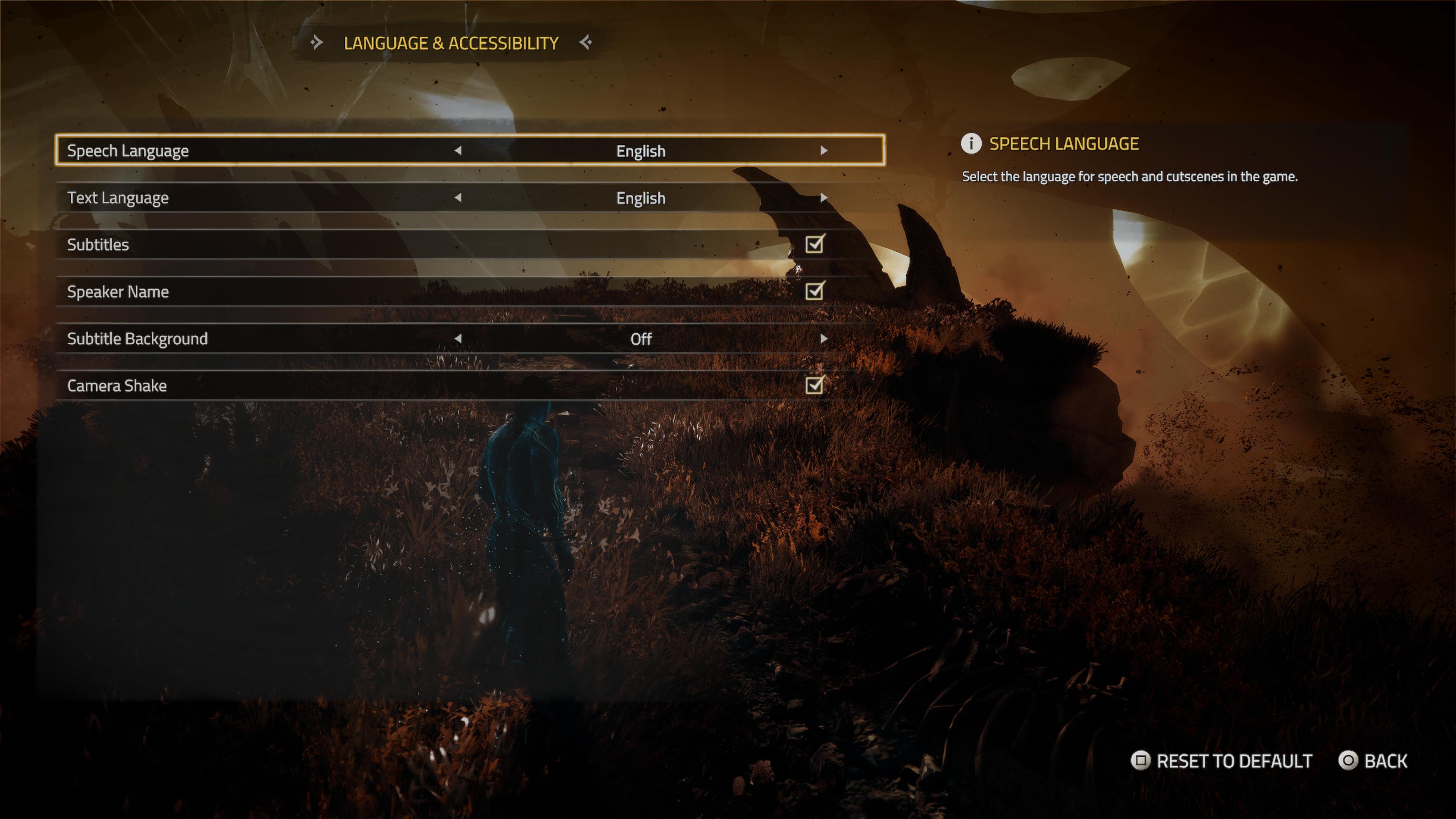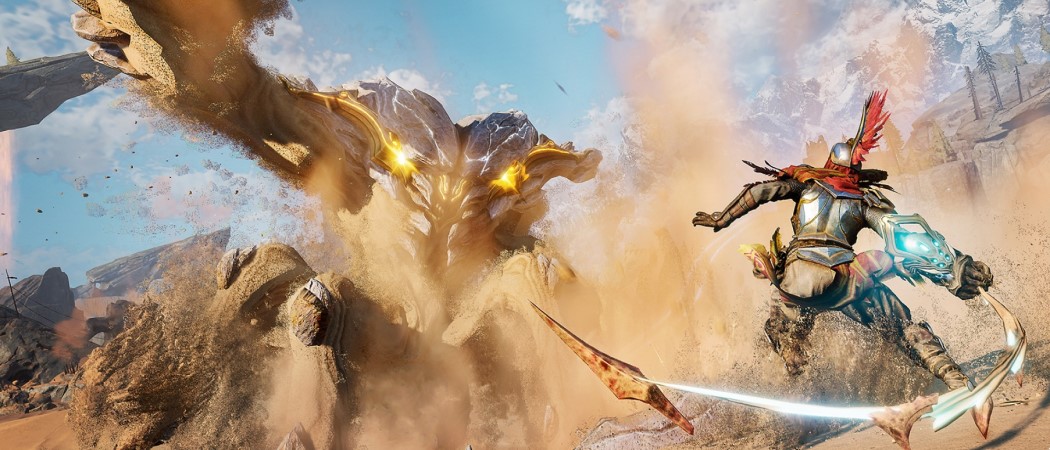TechRadar Verdict
Atlas Fallen is a solid but uninspiring open-world fantasy RPG with brilliant movement and traversal but not much else. In a crowded field of fantasy RPGs, it doesn’t have the level of finish, characters, and story to make it a truly memorable experience.
Pros
- +
*Excellent* traversal and movement
- +
Fluid combat
- +
Interesting world and pretty environments
Cons
- -
Wooden characters and dialogue
- -
…that’s sometimes too complex
- -
Plain story
Why you can trust TechRadar
Platform reviewed: PS5
Available on: PS5, Xbox Series X|S, PC
Release date: August 10, 2023
The traversal in Atlas Fallen is one of the best in years. Skimming and gliding across its vast sandy landscapes with supreme elegance, ease, and smoothness is a mastery that’s a joy to control, while airborne dashes and double-jumps make crossing chasms and cliffs a breeze. However, while getting around is undoubtedly the highlight, the rest of the game fails to offer a similar high, with wooden characters, a disappointing narrative, and complicated combat letting it down.
Atlas Fallen is also a ‘Soulslite’. Souls-ish staples like respawning enemies, a rechargeable Estus flask-style healing idol, Bonfire-alikes to save or upgrade your gear, and challenging (but not brutal) encounters, will make it feel like a Soulslike, but in reality, it’s more than that. However, at its core, this is much more of an action-adventure game and when you look at all its parts holistically, certainly doesn’t feel like the genre it’s aping in play. It is, however, a fun entry into the RPG and open-world fantasy libraries despite its lack of polish in places.
Sandscapes and sand surfing

Taking place in a fantasy world that’s unbelievably sandy, Atlas Fallen opens by going through some typical tutorial motions - a dream sequence teaching you basic combat and movement, and setting up the story in a nomad camp, complete with some character customization to make your avatar, in the middle of nowhere - before unleashing you into the world, and its best bits. However, like the wider story, the setup of the narrative is a well-trodden one: your character of lowly origins has a magical dream and finds a magical item to begin a kinship with a mysterious being and can begin to wield powers through the discovery of a powerful, but incomplete, gauntlet.
That world is made up of four main maps or areas, each with a central hub or settlement, expansive landscapes to travel across - and plenty of sand to shoot across. Each area and environment is worthy of the exploration time you’ll need to find all of the open-world game in 2023 trappings, featuring collectibles like lore, treasure, puzzles, and secrets. The benefit of taking the time to investigate the landscape is that you’ll also immerse yourself in some beautiful landscape spots and enjoy some fine vistas - from old decrepit ruins, sand-eroded caves, and expansive dunes or woodland.

Nothing beats surfing, skimming, and gliding across the sands in Atlas Fallen; it’s fluid, fast, agile, and every moment is fun. Combined with some aero-acrobatics, and the traversal of the game’s world is some of the best I’ve experienced in years.
It’s easy to fall for the beautiful vistas and crumbling ruins that make up the world of Atlas Fallen, but what makes this world one of my favorites from the last few years is the way you move through it. The traversal in Atlas Fallen is awesome. Strapping on the magical gauntlet gives you several powers, borne of the sand, including the ability to surf it. This isn’t just a sprint replacement service - you can twist and turn at will, your character leaning down as if they were a snowboarder to help turn corners. It even sounds brilliant; scuffed sand makes an ear-pleasing noise as you blast toward your next quest, hunt, or enemy.
There are rare moments when the surfing felt a little imperfect when transitioning from sand to another surface, or vice versa, but overall, it’s far and away the best part of the game. Deck13 knows this too, with designed-in functions like auto-collection of resources helping to keep the surfing experience uninterrupted and smooth.
But it’s not a case of splurging the game’s best feature in one early hit - your full suite of traversal moves grows with the story, and you’ll be adding to your repertoire of movements quite deep into the game, thus gaining more opportunities to mix it up and keep your movement feeling fresh and smooth.
Sign up for breaking news, reviews, opinion, top tech deals, and more.
Not handmade, but sand-made

The way your sand-made weapons tear their way out of your gauntlet within milliseconds of a button press, comprised of the sand surrounding you, is remarkably cool and adds a level of seamless fluidity to each fight. As soon as you can think of going to town on an enemy you’re already wielding the weapons and smashing them on your foes.
There are three sand-borne weapons that you can equip a pair of - a balanced hammer, a spikey glove, a super-fast whip - and each has a bunch of moves that you can master and combine too, extending the attacks beyond the standard ‘heavy’ and ‘light’. Simple stuff, but it layers complexity by moving away from a traditional stamina bar and instead has you building up Momentum during fights. This is granted with each hit you make on your enemies and opens up several special moves at different thresholds - similar to that of stamina slots in Assassin’s Creed Odyssey and Valhalla. Striking enemies also recharges the healing idol encouraging some aggression in your combat so as to gain healing charges - though this can also lead to some agonizing moments when you’ll be one hit away from said heal, only to be hit by a rogue swinging claw at the last moment.
Enemies of a certain size canteen be strategically taken apart
Your sand-made arsenal is further enhanced by Essence Stones; these are your passive or active equippable abilities, buffs, and skills; these can take your combat to another level and offer the chance to really personalize, and experiment with, your preferred combat. Almost all are upgradeable with resources and you can build up an approach to battle with these alone: equip damage-focused skills like a sand tornado, give yourself a boost of momentum as each fight begins, create areas of energy that slow projectiles and enemies down, or concentrate on durability by going for extra defense and healing effects. At some point, though, you’ll likely have problems with your build, whichever way you commit to. But you’ll be well-catered to switch your character’s focus as there are plenty of Essence Stones available to use or upgrade.
Changes in style will be a consideration once you factor in enemy variety and types, as things change from four-legged ground beasts and larger sandworms to massive crab- or bull-like creatures. Those enemies of a certain size canteen be strategically taken apart; body parts of the larger enemies will have their own amount of health that you’ll have to take down - something Deck13 introduced in its The Surge games. This can increase the amount of complexity in combat further - particularly if you have to maintain being airborne to attack a head or a flying creature. That said, the extra targets can make fights a little more nuanced as you can target particularly potent attacks or limbs first in an effort to nullify an enemy. However, it can be frustrating when after taking an enemy's head, the rest of its attacks can be delivered just as viciously and effectively.
The results of all these parts mean Atlas Fallen’s combat is fast, fluid, and frantic
You can also take evasive action: you’ve got a block that can freeze enemies when a parry is timed perfectly and the ability to dodge by rolling on the ground or jetting in the air. While having these is welcome, both can actually serve to complicate combat, especially when you’re frantically fighting multiple enemies; both have to recharge and you can be left without either if you miss time them slightly.

All in all, though, the results of all these parts mean Atlas Fallen’s combat is fast, fluid, and frantic. However, sometimes it’s a bit too frantic and thus has a tendency to be over complex. The combination of weapons two weapons, each with its own combinations, the constant eye on momentum build-up, the button-combos to heal or use skills attached to the idol, and the role of dodging and blocking means that some combat scenarios become dangerously close to button mashing. This cheapened the combat somewhat and meant that the combat can be simultaneously enjoyable but tiresome as you rely on a few effective methods; no matter how satisfying it was to build up to a shatter attack - freezing the enemy and delivering high-damage blows - it had a tendency to become a regular, uninspiring pattern.
Atlas Fallen’s take on the good vs evil tale is a well-trodden one. It’s a familiar story of a person of lowly origin, finding a magic item, becoming powerful, and channeling the spirit of one god to take on another. Bits of the story were even quite predictable early on, and the supposed crescendos when moving into new areas felt a little anticlimactic narratively, but the big gauntlet upgrades that tie closely to the story and punctuate the adventure - often with boss fights or multi-phase quests - did feel more significant and meaty; the narrative journey failing to mirror and match pace with the game’s mechanics’ journey.
Atlas Fallen, then, is a mixed bag - but also rather a ‘mid’ bag. Its traversal in the shape of the exquisite sand surfing and hangtime-tastic jumping and dashing will stay with me for a long time, but the story, characters, and parts of the combat are largely middling and shrug-worthy. This will ultimately stop it from shining in a year when we’re eating very well at the fantasy RPG adventure table. While there’s potential here, it feels like Atlas Fallen just isn’t quite the sum of its parts.
Accessibility

There are only a few dedicated accessibility functions and features in Atlas Fallen, with the majority of them geared toward language and subtitles. Outside of that, there is one option to turn on or off the camera shake. Overall, this is lean, and some more features - even the addition of subtitle size differences - would be most welcome.
How we reviewed Atlas Fallen
I played Atlas Fallen on PS5. My playthrough took me about 12 hours to complete and included a host (but not all) of the side content. I played the game in both its performance and quality-focused modes and found the performance mode to be more suited to the game’s emphasis on fluidity and movement. I found there to be only very minor performance issues in the busiest city, and only for a few minutes only. I played the game on a Samsung 4K TV and used both a soundbar and headset for audio - deploying the latter when playing a couple of hours of co-op - and also tested the game via PS Remote Play, streaming the game on my gaming PC (that's teamed with an Acer Predator X38 monitor supplied by Acer) from my PS5.
Atlas Fallen releases August 10, 2023, on PS5, Xbox Series X|S, and PC. See how it compares to our takes on the best PS5 games, the best Xbox Series X games, and the best PC games that you can play right now.

Rob is the Managing Editor of TechRadar Gaming, a video games journalist, critic, editor, and writer, and has years of experience gained from multiple publications. Prior to being TechRadar Gaming's Managing Editor, he was TRG's Deputy Editor, and a longstanding member of GamesRadar+, being the Commissioning Editor for Hardware there for years, while also squeezing in a short stint as Gaming Editor at WePC just before joining TechRadar Gaming. He is also a writer on tech, gaming hardware, and video games but also gardens and landscapes, and has written about the virtual landscapes of games for years.
